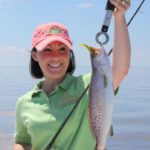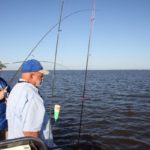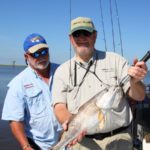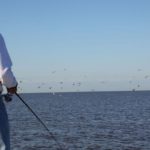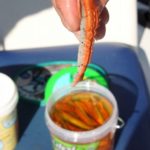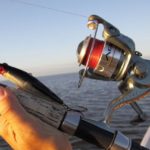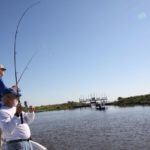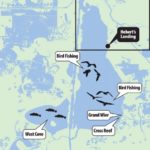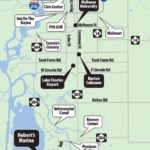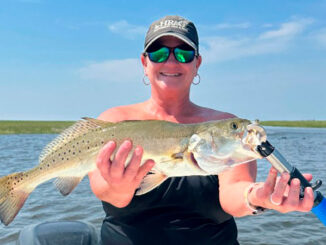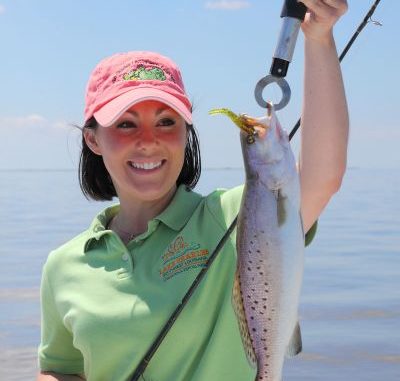
This Big Lake guide is always busy, but his favorite activity is catching the lake’s trout. Here are his tips for catching numbers — and how to target bigger specimens.
Sammie Faulk is a man on the go. He is chairman of the Cameron Parish Tourist Commission, a consultant for the Southwest Louisiana Convention and Visitors Bureau, and vice-chairman of the board that governs the 180-mile Creole Nature Trail, All American Road and National Scenic Byway.
And if that isn’t enough to keep an average man busy, he also is a tour guide for Grosse Savanne Waterfowl and Wildlife Lodge.
The fact is Faulk isn’t an average man.
He also is the captain and owner of Gotta-Go Charters, an appropriate business name for a man who has been guiding on Lake Calcasieu the late 1970s.
And he knew exactly where he was going on this trip.
Spotting a fairly large flock of laughing gulls off in the distance, Faulk motored his 23-foot bay boat toward them. Stopping just short of the birds, he let down the troll motor and maneuvered the craft stealthily into position.
The birds were frantically diving to the surface of the water, a telltale sign that speckled trout were working somewhere in the depths below, feeding on baitfish or — more probably —shrimp.
Tossing a black-and-silver Catch 2000 MirrOlure beneath the birds, I let it settle for a count of 1,001; 1,002; 1,003 before starting the typical twitch-twitch-twitch-reel, twitch-twitch-twitch-retrieve that usually solicits a strike right away.
The solid “whumf” of a speck hitting the lure stopped the bait halfway into my second series of twitches. There was no escape for the fish; the 10-pound-test line Faulk had loaded the loaner rod with was more than a match for the little scrapper that went no more than a couple of pounds.
Still, the brief fight was fun, and my speck went into the fish box along with several others our group caught until the raucous birds quit.
Faulk said there is a reason fishing under flocks of feeding birds — a tactic that every fishing guide and most anglers employ when fishing trout along coastal Louisiana from Lake Charles to Venice — is so effective.
“What happens is the fish — the big fish — are chasing bait,” he said. “And what they do is herd them up into a ball, and then they’ll just start going through them. The bait has only one way to go, and that’s up.
“And when they’re up on the top of the water, they’re jumping out of it. Here on Big Lake the water is not beautifully clear. But, it’s clear enough where the seagulls that are flying up high can see the predator and baitfish flashing — or shrimp jumping, which is what it is most of the time. When the birds start seeing the shrimp jumping they’ll come down and they never leave. They know it’s going to happen again in the next five minutes.”
Faulk said this bird-chasing tactic can happen anytime during the year — even in February, though it may not produce as much. Back in February a friend of his made a trip to Big Lake and found a small group of birds working. Faulk said that, before the bird flock broke up, his friend caught two fish.
It wasn’t much, but it proved that chasing birds can produce fish anytime.
However, it’s not until April and May when chasing birds really starts to produce numbers of fish, mainly because of bait size Faulk said.
“In the winter months most of the bait is small,” he said. “Like shrimp, for instance — there’s not many shrimp. So, at that time of the year the bait is going to be fish — like pogy. Shrimp in Big Lake during the winter are going to be no more than three-quarters of an inch to an inch long and just beginning to grow. So they’re not going to be jumping out of the water. But, the fish are there.”
Of course, that changes as summer approaches.
“Normally, the brown shrimp season opens in the middle of May and runs for 30 days, closes for 30 day and opens again for the rest of the summer,” Faulk said. “Then it’s the white shrimp. The shrimp grow at a tremendous rate. It’s really unbelievable.
“And that’s when the birds start working.”
Faulk said soft plastics like split-tail grubs, cocahoe minnows and swim baits are effective lures to fish under birds, mainly because they are the fastest and easiest to use, come in a wide range of colors and are easy to change — especially when the intensity level is up.
“It gets pretty intense, and it’s a lot easier to take a fish off a single jighead hook than a Catch 2000 with two or three treble hooks,” he said. “It’s the ability to change quickly from a chartreuse-colored bait to white or clear glitter bait while using a single hook on a jighead. And, that’s basically what most people do.”
On my outing with Faulk, we also used Berkley Gulp! shrimp, which proved to be effective, as well.
But no doubt some of the attraction for those who frequent Lake Calcasieu is the opportunity to catch big trout. The lake attracts numerous recreational anglers, and the pressure on speckled trout is quite heavy. Therefore, the lake has a restricted limit where trout fishermen can only take 15 spotted seatrout, of which only two can be over 25 inches in length.
“We’ve got a tremendous number of fishermen here,” Faulk said. “And we have a lot of guides and a lot of recreational fishermen that come just to fish trout. It’s good, and a lot of people will catch their limit.
“But we have that limit because we put a lot of pressure on trout. Plus, we catch some big trout.”
What makes Big Lake’s trout so big? It all goes back to the abundance of bait — in particular menhaden, also known as pogy.
“It all has to do with the food,” Faulk explained. “Although most people are fishing the birds over shrimp, the shrimp are not what makes fish grow big; the big fish come from menhaden.
“The pogy has so much protein in it it’s unbelievable. It would be like these guys on steroids bulking up and being on the A team or real high in the batting order. Pogys are really, really good and builds them up to be big, fast and strong.
“I’ve known some people who’ve gotten broken off by big trout. There are some big redfish in Big Lake, but there is also some big trout, too.”
One of the tricks Faulk uses to catching some of the bigger trout is to fish a little deeper.
“A lot of times someone will be fishing a popping cork about 12 to 14 inches deep using a split-tailed grub, cocahoe or something and they’ll catch smaller fish,” Faulk said. “But then there are those who fish something like a Catch 2000, spinnerbait or Rat-L-Trap and let it sink. They’ll count to about three, and then start to retrieve.
“That will put their bait about 24 to 30 inches deep swimming back, and they’ll catch better fish — maybe 2 ½ or 3 pounds on up to 5 or 6 pounds. When you fish on top, you’re going to catch a lot of 1 ½- to 2-pound fish.”
Big Lake has lots of diversity that also appeals to many anglers. Besides speckled trout, the system also has tremendous redfishing opportunities, along with black drum and flounder. Faulk calls a trip that produces reds, black drum and flounder the “Cajun Grand Slam.”
For redfish and flounder Faulk recommended using Gulp! shrimp.
“The scent that’s on it apparently is as close to the real thing as you can get,” the guide said. “It’s got all of the colors, and works really well. I know a lot of people who use it just like a piece of dead shrimp on the bottom with a lead head; redfish, black drum and flounder will pick it up and take it.”
Like the man on the go he is, we didn’t waste time chasing every flock of birds we saw. Instead, Faulk showed us the lake’s diversity, changing up entirely and targeting redfish at the Grand Bayou weir.
Recreational anglers coming to fish Big Lake for the first time should make note of this location.
The weir is an excellent ambush location for redfish. The tidal movement through this spot concentrates the bait as it passes through the weir, causing redfish and other target species to congregate there.
Those in our party fished Gulp! shrimp on the bottom at the weir. The Grand Bayou location allowed Idaho angler Dennis Udlinek, a man who is used to catching big fish in the form of steelhead trout and salmon in the Pacific Northwest, to catch his first redfish — one of reasons for his coming to Louisiana.
Faulk also fishes West Cove, another popular location on Big Lake, and mentions this part of the lake is good because it’s so fertile.
“It’s like one massive oyster reef,” Faulk said. “It has an island in the middle of it, but what happens is there is always a current, in a sense, in West Cove. It may not be too visible but, because of the island, anytime the wind blows north, south, east or west it’s going to start that water moving around the island. It’s not just going to sit there when the wind blows; it’s not just going to push across. With the island, it has a tendency to move around the island.
“It moves over the oyster reefs and stirs up all of the bait. It stirs up invertebrates, all the shrimp, the cacahoes and menhaden — all that stuff. And, they really catch a lot of fish there. There are a few places better than others, but it doesn’t really matter. You just can’t barely take or put your push pole down and not hit oysters in West Cove.”
Faulk is someone who’ll take time to tell you where he’s going if you ask. He loves to promote what Southwest Louisiana has to offer. And if you’re ever on Lake Calcasieu and see him, it won’t take long for you to realize why his guide service is called “Gotta-Go Charters.”
